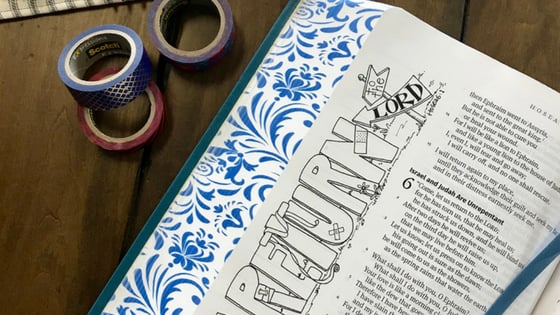Bible journaling is a thing right now. Instagram is filled with photos of people strategically placing their margin drawings alongside their coffee cup and a vase of flowers.
At first glance, you might assume that Bible journaling is just about coloring. That’s not all bad, is it? What better way to improve on an enjoyable, stress-relieving activity such as coloring than by coloring the Word of God?
There is, however, much more to Bible journaling—or visual faith as some of us call it—than just coloring in your Bible.
Bible journaling is a form of marginalia, which refers to anything added to the blank margins around the text in a book. Marginalia allows readers to join in the conversation on the page of a book and remember what was said! Writing in the margins helps you relocate important points, retain information, and connect it to your present situation—it helps you get something out of the book.
It’s easy to feel over-scheduled, over-stimulated, and over-stressed by the pressures of life. The world tells us that if we pause or hesitate, we might fall behind or miss out, so we often feel the need to multi-task—and then we wonder why we have trouble concentrating.
All this can affect our quiet time with God, our ability to be still and know and to really hear and remember His conversations of truth and grace that we so desperately need.
I’ll admit that I’ve struggled for years with reading my devotion or hearing a great sermon and then not being able to remember or talk about it the next day—or even later the same day!
Journaling Bibles provide extra margin space for putting pen to page while reading God’s Word. The process is simple: you read, you pause to reflect on the passage or verse, and then you respond by writing a portion of Scripture, an expression of faith, or a prayer in the margin.
Taking extra time to add an illustration or color to your lettering adds to the meditation time and provides a picture in your mind to take with you through the day. I have found that by slowing down, I am more likely to have the Word ready to share with others as God presents opportunities in my daily life to reach out. It also creates a kind of faith story of my life and becomes a legacy to leave behind for my family.
Benefits of Bible Journaling
Bible journaling isn’t rocket science, but it is supported by educational research. Since about 70% of people are visual, kinesthetic, or tactile learners, educators wisely provide pictures, flash cards, and hands-on activities to help children learn in school.
Bible journaling is simply applying these techniques to help us learn and remember God’s Word.
When we pause to think about what we read, connect the truths to what we know and are experiencing, and then respond with our own words, information is taken in and retained—meaning that, when we Bible journal, God’s Word sticks in our heart and on our lips to share with others.
There’s also the see-and-remember principle (see Deuteronomy 6:6–7, Joshua 4:20–24, Psalm 78:4–6). We need to remember important things, but our hectic life makes that a challenge.
Bible journaling creates a space to connect with God and remember His promises. Because we easily forget.
For instance, taking sermon notes is encouraged by many pastors and is often assigned to confirmation students. But what if those notes were brought home and tucked into your Bible on Sunday (instead of adding them to the pile on the counter or tossing them out)? And what if you took 15 minutes later in the week to organize and write them in the margin next to the text, maybe adding color or an image if you were inspired to do so? Or, what if you took a few extra minutes to add some impactful take-aways from your daily devotion into the margin? You might discover that this process helps you remember and use those Words of life to encourage others—or yourself.
Even if you don’t think you’re artistic or creative, give it a try. Bible journaling may not be for everyone, but everyone can benefit from a different perspective and meditating on the Word of God.
Finding a Journaling Bible
The new Enduring Word Bible provides space for this in the two-inch margins of each page. Lines in the margins make it easy to journal notes and prayers or create lettering art and images. And if you like to color but hesitate to add your own pictures, there are over 350 hand-drawn Scripture illustrations included in the Bible.
I was privileged to be one of the four artists who contributed artwork to this Bible. It was an honor and a blessing to reflect and ponder each of my assigned verses, to create lettering and images to encourage you in your reflection time, and to pray for all who might be blessed by spending time in The Enduring Word Bible.
It is my prayer that your time in God’s Word might be blessed as you consider slowing down a bit to journal. And as you make connections between the Word and your world, recording the story of God’s faithfulness in your life, I pray that it becomes easier to remember and tell that story to the people God places in your path each day.
Get started on your Bible journaling journey with The Enduring Word Bible!
















